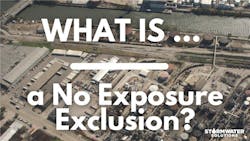Key Highlights
- No exposure means all industrial materials and activities are sheltered from stormwater contact, requiring continuous oversight and strict controls.
- Qualifying facilities must use structural BMPs like permanent roofing and enclosed storage, along with housekeeping practices such as spill cleanup and equipment maintenance.
- Exposure incidents require immediate action, including stopping discharges, applying for permits, and developing SWPPPs to avoid penalties and regulatory violations.
In industrial stormwater regulation, a no exposure exclusion provides an alternative compliance pathway for facilities that can keep all industrial materials and activities completely sheltered from precipitation. Under the Clean Water Act, most industrial operations that could affect stormwater quality must obtain an NPDES industrial stormwater permit. But if a facility can demonstrate that nothing that might contaminate stormwater is exposed to rain, snow, snowmelt or runoff, it may qualify for this conditional exclusion.
For many operators, the no exposure pathway can simplify compliance obligations, reduce reporting requirements, and limit monitoring. But it also comes with strict criteria and a need for continuous oversight to maintain eligibility.
What does “no exposure” mean?
EPA defines “no exposure” as a condition in which all industrial activities and materials are sheltered by a “storm-resistant structure” that prevents contact with precipitation. This includes raw materials, intermediate products, byproducts, waste materials, process liquids, industrial machinery, loading and unloading operations, and material handling equipment.
If any regulated material or activity is left outdoors or in a condition where stormwater could reach it, the facility is not eligible. Even temporary exposure—such as leaving materials uncovered during a maintenance project—can void the exclusion.
Who qualifies for the exclusion?
Most industrial categories regulated under EPA’s Multi-Sector General Permit (MSGP) can qualify as long as they maintain continuous storm-resistant shelter. However, the exclusion cannot be applied to active construction sites that disturb 1 acre or more, as those activities inherently involve exposed soils and materials.
The exclusion must also apply on a facility-wide basis—operators cannot claim no exposure for some areas but maintain permit coverage for others.
What does it mean to have no exposure?
To qualify, industrial sites must demonstrate that:
-
All material handling and storage occurs indoors or under complete cover.
-
No industrial wastewater, sludge, or process materials are stored outside.
-
Secondary containment systems are covered or otherwise protected from rainfall.
-
Vehicles and equipment exposed to rain do not leak fluids.
-
No particulate matter from industrial processes can be mobilized by stormwater.
- Loading and unloading take place indoors or under a permanent roof.
The overarching principle: if stormwater cannot pick up pollutants at the facility, the operation does not need an NPDES stormwater permit.
What are the two types of BMPs related to no exposure?
While “no exposure” focuses on preventing stormwater contact, facilities often rely on two broad categories of BMPs to keep materials protected:
1. Housekeeping or preventive BMPs
These involve operational practices such as:
-
Sweeping material residues
-
Moving raw materials into indoor storage
-
Immediately cleaning spills
-
Keeping waste containers sealed
-
Ensuring outdoor equipment is clean and non-leaking
These practices minimize the risk of incidental exposure and support facility-wide compliance.
2. Structural BMPs
Structural controls physically prevent contact between stormwater and industrial materials. Examples include:
-
Permanent roofing over loading docks
-
Enclosed storage buildings
-
Covered dumpsters
-
Berms, curbing, or containment structures
-
Covered fueling or maintenance areas
For many facilities, qualifying for a no-exposure exclusion depends on the reliable performance of these structural controls.
What happens if exposure occurs?
No-exposure eligibility depends on maintaining continuous protection. If industrial materials become exposed—whether due to construction, equipment relocation, storage overflow, or operational changes—the facility must:
-
Immediately stop any unpermitted discharge,
-
Apply for NPDES stormwater coverage, and
-
Develop and implement a Stormwater Pollution Prevention Plan (SWPPP).
Failing to do so can result in enforcement under the Clean Water Act.
What are the penalties for not having a SWPPP?
If a facility loses its no-exposure status but continues to operate without an NPDES permit or required SWPPP, the operator may face significant penalties, including:
-
Notices of violation from state or federal regulators
-
Administrative penalties
-
Civil penalties, which can reach tens of thousands of dollars per day
-
Mandatory corrective actions
-
Additional monitoring or reporting requirements
The severity depends on whether the discharge caused or contributed to water quality impacts, whether violations were repeated, and whether corrective efforts were made promptly.
Why the no exposure exclusion matters
For stormwater professionals, the no-exposure exclusion is both an opportunity and a responsibility. When implemented correctly, it can:
-
Reduce regulatory burden for industrial operators
-
Lower monitoring and reporting requirements
-
Streamline facility operations
-
Limit pollutant loads delivered to local waterways
-
Support compliance with local MS4 and watershed plans
But because eligibility depends on continuous control of exposure, the exclusion also requires routine inspections, well-designed BMPs, and clear employee training.
As industrial sites evolve, operators must frequently reassess whether no-exposure conditions still hold. For many facilities, the exclusion is beneficial—but only when supported by durable shelter, strong housekeeping practices, and a commitment to maintaining compliance.
This piece was created with the help of generative AI tools and edited by our content team for clarity and accuracy.
About the Author
Alex Cossin
Associate Editor
Alex Cossin is the associate editor for Waterworld Magazine, Wastewater Digest and Stormwater Solutions, which compose the Endeavor Business Media Water Group. Cossin graduated from Kent State University in 2018 with a Bachelor of Science in Journalism. Cossin can be reached at [email protected].



